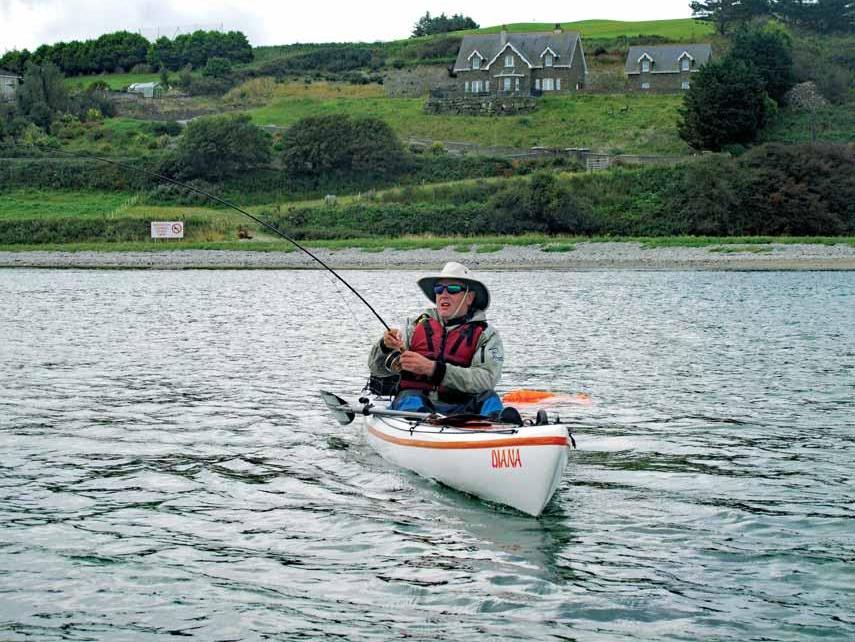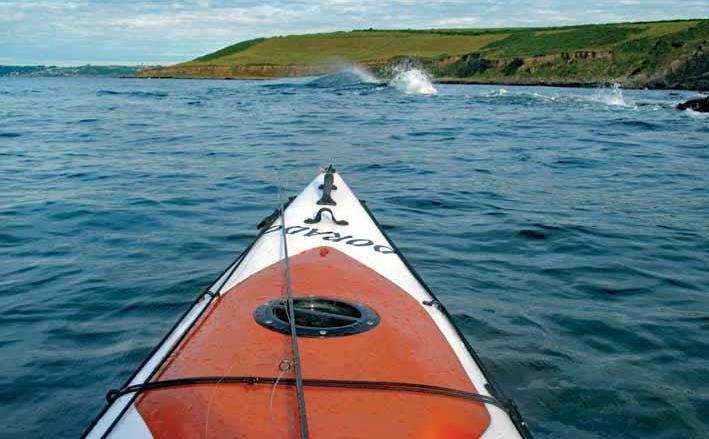
8 minute read
Kayak Fishing for Bass - By Simon Everett
KAYAK BASSING
The author bent into another bass.
Avisit to Ireland is one of my fishing rituals. The reason I make the effort to go is because the bass fishing over there is quite simply the finest in Europe. This is down to the brilliant fishery management they have in Ireland, for twenty years there has been no commercial landing of bass in Ireland, they have a closed season to protect the fish during their spawning period and anglers are restricted to two fish per day. The result is a staggeringly brilliant sport fishery that makes it worth the cost of going. In one day you can catch more big bass than you would in a month of bass fishing at home. Add to that the mild climate, the genuine hospitality and the craic that emanates from every pub doorway and you have a mouth-watering recipe for angling tourism.
I drove over with the kayak on the roof, opting for the Holyhead – Dublin ferry with Stenaline. Their ferry times are very civilised, leaving at 08.20 and returning at 21.30 these crossings effectively give me an extra day of fishing in my timetable. The road from Dublin west is very easy now and Cork is only three and half hours, even going steady with the kayak on the roof.
I set the alarm for an early start, I wanted to be on the water for 05.30, just about as it was coming light. As I drove down the narrow, bumpy lane to the slipway and small beach on the coast of County Cork the sea was flat calm. There was barely a ripple and there were no waves hitting the shore. These are not good conditions to go in search of bass. I like a bit of movement on, or in, the water and some white water from breaking waves on the shoreline helps too. The one thing in my favour was the fact that it was a spring tide and hopefully the tidal push would bring the bass on the feed.
In these clear, calm conditions I was putting my faith in the fly. For some reason a fly seems to work better when things are not quite right. Whether it is the subtlety of movement that gives the bass the confidence to take I am not sure, but I have been in conditions like these before where lure men have failed to interest a single fish but fishing a fly has accounted for several fish. I have also fished alongside commercial guys using both live eels and live prawns and they didn’t touch a fish, but I was doing well just 30 yards from them fishing one of my special bass flies, much to their annoyance.
So it was with confidence that I rigged my fly rod, a 9-foot Orvis Helios rated for a #8, with a Rio Aqualux striper clear intermediate line. On the end of that I had a Mirage saltwater leader, it is pure fluorocarbon and I tie an additional length of 20lb Mirage to the end, to give me a working length


Simon’s fly gear and one of his successful bass flies. without cutting into the tapered leader tied on a 1/0 hook and was about 5” as I change flies. long. That is all there is to it, fly fishing
When the working length gets a bit is so simple and yet so effective, short I simply nip it off and tie on especially from the kayak. another 3 feet of working end. On the business end went a baitfish pattern of Here was moving water created my own tying, it has proved very by the surge from the reef break effective in various sizes, this one was I paddled out from the shore heading for a stretch of shore reef that is usually productive, but when I got there the water was cloudy. I don’t like fishing in cloudy water, not when clear water is available close by, so I turned round and paddled along the coast the other way to a stretch of broken rocks that is another spot that produces. There was a little bit of swell rolling in, imperceptible while paddling but the building wave over another shore reef and the steep breaker that was crashing down on the rocks was all the hint I needed. On an otherwise quiet shoreline this was the one area where there was moving water, created by the surge from the reef break and the push of the tide around the rocks.
The wind was blowing me offshore, so I paddled right in close to the rocks, almost within touching distance, and drifted out just clear of the rearing wave. I was able to cast my fly right into the white water at the base of the rocks and strip it back around the rocks and up the gullies between the pinnacles. On the second cast, just as I was drifting level with the crest of the wave, I got a take. It wasn’t a firm take though, but it gave me renewed


Sometimes falling back on previously gained knowledge pays dividends and this was such an occasion. My plan was to go the other way, but the conditions meant I had to change my mind and go with instinct, born out of a mixture of blanks and successes. The knowledge accumulated in this way gives us the tools to work with. On this occasion my choice had worked, on other days they don’t, but you can still learn from the result. I did a couple more drifts on this breaking wave and caught two more fish, like peas from a pod, they were all around the same size. The same fly did the trick each time, it was working so why change it? Unless to experiment. I wasn’t in the mood for experimenting, I had come a long way and I wanted to make the most of my fishing time and catch a few fish.
The fly when it was slammed by something powerful
After the third bass had landed on my lap there was a lull. I did several more drifts without so much as a touch. Then as I cleared the reefy area and hit slightly deeper water I gave the fly a much longer countdown, instead of fishing in the top two feet, I let it sink for about 6 feet. I had only just started to retrieve the fly when it was slammed by something powerful. I played the fish out, thinking as it stayed deep it was going to be a bigger bass, until I saw the golden brown of a pollack coming up through the crystal clear water. It wasn’t a big one, about 4lbs so worth catching. However, I messed around too long with it and it threw the hook into my lap as I tried to grab its jaw with my thumb and finger. Had I bothered to take the landing net no doubt I would have boated it. I wasn’t worried, I would have put it back anyway. It did signal to me that I needed to move though.
A nice looking bay down tide was beckoning and I paddled across looking into the water with my Polaroid sunglasses. I was crossing an area of alternating weed and rock and I immediately thought it looked fishy. I set up a drift that took me parallel to the shore, using the drogue this time to angle the kayak to the wind, which wasn’t quite so offshore now. It was only about three casts in to this drift that I got another take. I had counted the fly down what seemed like a lucky number, 7 seconds, and started to retrieve in staccato pulls. The line tightened and the fish threw its head. This was a feisty fish, it was fighting faster than the others had and I combined letting it take line out through the rod and winding in what was lying in my lap at the same time, until I was playing it off the reel. It ran hard and fast four or five times before boring deep for the weed. It got into the weed and I expected to lose it, and possibly my fly too. Thankfully, having learned from last year, I had stepped up my leader from 12.5lbs to 20lbs and this gave me enough additional strength in the system to pull the fish out of the weed. It turned out to be the smallest bass of the day, weighing in at 4lbs 8ozs, but what a scrapper!
I had had the best of it by now. The tide was easing and fish were getting harder to find, but they were still taking if you could put your fly in front of them, as this last fish proved. Sometimes though, it is best to finish on a high note and that is exactly what I did. I called it a day having caught 6 bass between 4.5lbs and 6lbs and a brace of Pollack for variety. The shore anglers I had seen making their way along the rocks returned to the car park at the same time I did. Naturally we swapped notes and they had not had so much as a swirl between them. On days like this there is little to beat getting out in the kayak, and using a fly, it really does give you a genuine advantage.
I travelled with Stena lines from Holyhead to Dublin Port. There are often ferry saver deals for a car and two passengers which makes it an affordable trip and a choice of either Holyhead to Dublin or Holyhead to Dunlaoghaire. For those living in the south an alternative route would be from Fishguard to Rosslare. The road network in Ireland is such that you can drive to Cork from Dublin in just over 3 hours, even with the kayak on the roof. I only cruise at a steady 60 mph, which saves a considerable amount of fuel due to the windage of the roof load. Accommodation was with friends, but there are plenty of angler friendly B&Bs.












